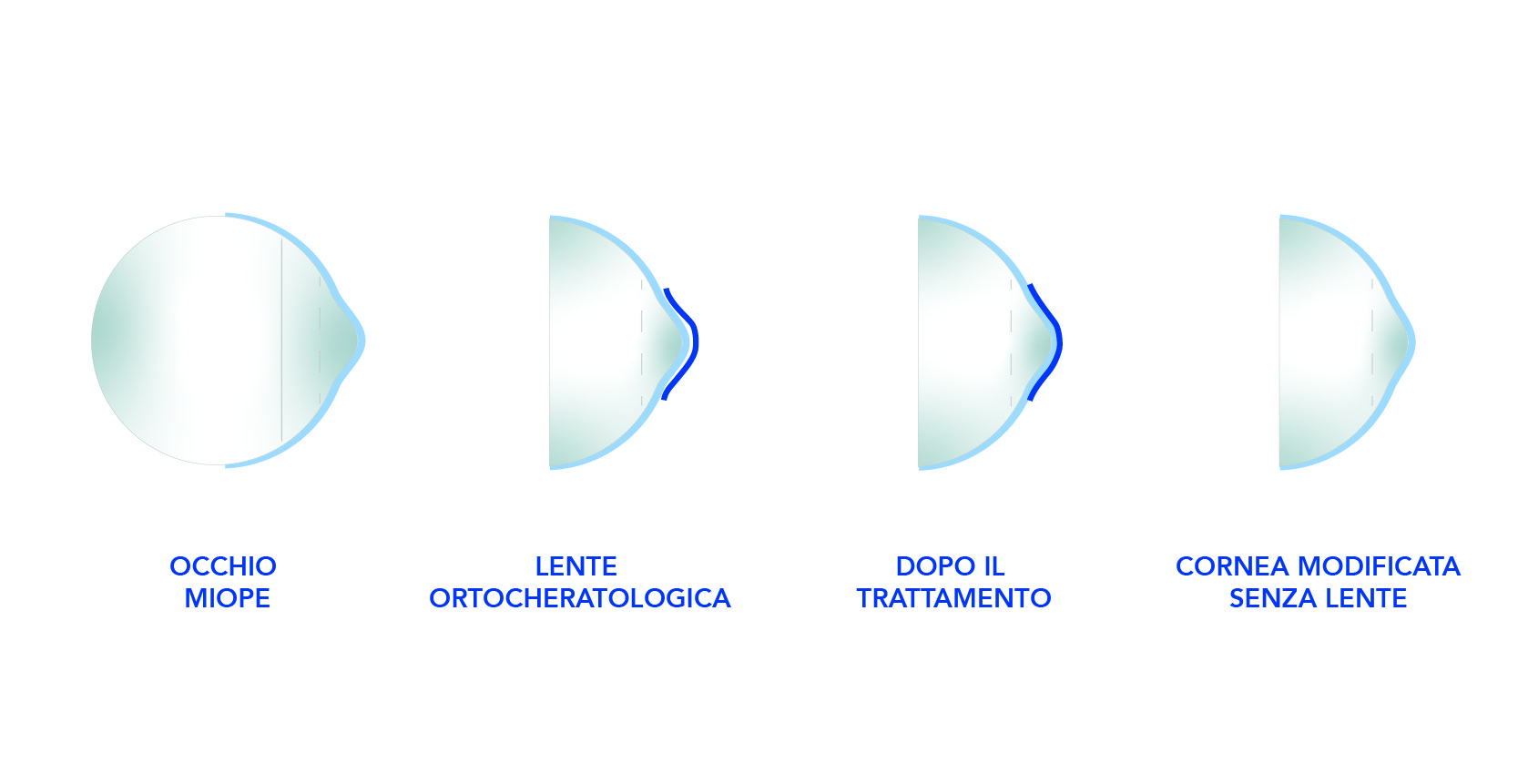Orthokeratology: the non-invasive practice that treats visual defects

Myopia is considered the most common ametropia among the visual disturbances of the human being. Many think that this disorder, because it causes blurry vision, can be corrected simply with an appropriate prescription.
Myopia is considered the most common ametropia among the visual disturbances of the human being. Many think that this disorder, because it causes blurry vision, can be corrected simply with an appropriate prescription. But this is not always the case: it can progress over time, reach high values and transform from a visual defect into a real pathology with serious consequences. Thanks to studies in this area, science has come to a new methodology that takes the name of orthokeratology, specific in the treatment of myopia as it can help reduce the value of this visual disorder.
The treatment consists in the application of rigid or gas permeable lenses during the night. These lenses modify the morphology of the cornea for a certain period of time in such a way as to guarantee the wearer correct vision throughout the next day. Let's see in more detail what the practice of orthokeratology consists of.

The birth of the scientific method
The orthokeratological technique or ortho - K application has been used since 1960 in the United States by Jeorge Jessen, who was not only an optometrist but also a pioneer of contact lenses. Dr. Jessen was the first to try to change the value of refractive myopia thanks to the use of rigid contact lenses using a technique called Ortofocus. These innovations in the vision sector originate from studies carried out by Robert Morrison in 1956: from his works it was highlighted that the 1000 young people, corrected with rigid contact lenses that are flatter than those used up to then, did not show myopic progression. But despite the evident results deriving from these experiments, for more than twenty years orthokeratology has not received official recognition as an effective cure for visual problems resulting from myopia. To date, however, it is one of the most used treatments to correct myopia without resorting to surgery which allows, with a non-invasive technique, to achieve excellent results.

Le fasi della visita ortocheratologica
LOrthokeratology consists in the use of gas permeable contact lenses with specific geometries to reshape the corneal surface in order to obtain a decrease in apical sagittal depth (flattening) of the cornea, reducing or eliminating the need for a myopic correction, through the continued night use of these lenses.
Let's examine the general application process through these phases (the first three involve the application process, while the last two concern the adaptation of the lenses):
- Phase 1 - In this phase, the choice of the initial lens takes place through a nomogram or specific software.
- Phase 2 - In the second phase, the evaluation of the trial lens takes place after a period ranging from 10 to 30 minutes from application. In this case, the optometrist can assess whether the wearer of the lenses has a real flattening effect and whether it is suitable for the treatment.
- Phase 3 - At this point, we proceed with a further check during which the optometrist will evaluate the result after 4 or 6 hours from the application of the lenses on the wearer's eye.
- Phase 4 - During this phase, the optometrist explains how to wear the lenses during the first night, and then proceeds to an evaluation of these three fundamental characteristics for orthokeratology:
- Centering: if the lenses are off-center they will not produce the desired effect.
- Movement: the lenses should move 1-2 mm with the blink. If this does not happen, they will need to be replaced with a flatter pair.
- Fluorescein pattern: this phase consists in noting the size and shape of the tear deposit, the movement of the lenses, in observing any signs of adhesion of the lenses, the tear reservoir, if the lenses appear narrower and the possible presence of dots (since a well-fitted lens shouldn't cause stippling).
• Phase 5 - This last phase consists in the assessment of vision without the application of any aid, in performing a refraction and, finally, a corneal topography in order to determine the changes in the shape of the cornea.

The benefits of orthokeratology
Below you will find the main advantages deriving from the choice to rely on orthokeratological treatment for the treatment of myopia. In fact, thanks to orthokeratology you will benefit from: - improved vision without laser surgery;
- improvement of vision without the use of glasses or lenses throughout the day and from the first days of application;
- orthokeratology is suitable for all ages;
- if you play sports, you can benefit from freedom and movement without the use of devices;
- prevents myopic progression;

Do you still have doubts? Here are the answers to some frequently asked questions
How do orthokeratology lenses work?
The lenses for Orto - K are designed to progressively reshape the central surface of the cornea, with an effect similar to that obtained with laser treatment in myopic subjects. However, unlike laser treatment, the effect of orthokeratology is temporary and reversible.
How safe is orthokeratology?
Orthokeratology is very safe when the lenses are correctly applied and managed appropriately. Many people have been able to eliminate their addiction to glasses or standard contact lenses without side effects.
Can orthokeratology help children and adolescents?
Yes, this methodology is used to slow down myopia or delay its progression and to correct refractive errors.
Are these lenses comfortable at night?
Yes, they are surprisingly comfortable. Most wearers do not perceive their presence in the eyes, already a few minutes after wearing them.
How long does it take for the treatment to stabilize and start seeing correctly during the day?
Generally, it takes four to seven consecutive nights of wearing the lenses, taking into account the personal variables of adaptation to orthokeratology.
For more information about it, book a specialist visit with the optometrist Bruno Lucciola in our specialized center and benefit from a non-invasive method to treat the visual defect resulting from myopia.
In Same Category
- Revolutionise your sight with Zeiss SmartLife lenses available at Ottica Lucciola
- Clarity Unleashed: Explore Multifocal Contacts for Presbyopia
- Ottica Lucciola: The Expert Choice for MiYO SMART Lenses and Your Children's Visual Well-Being
- Collezione di occhiali Chiara Ferragni: unicità e glamour
- RODENSTOCK: le Lenti Biometriche intelligenti
